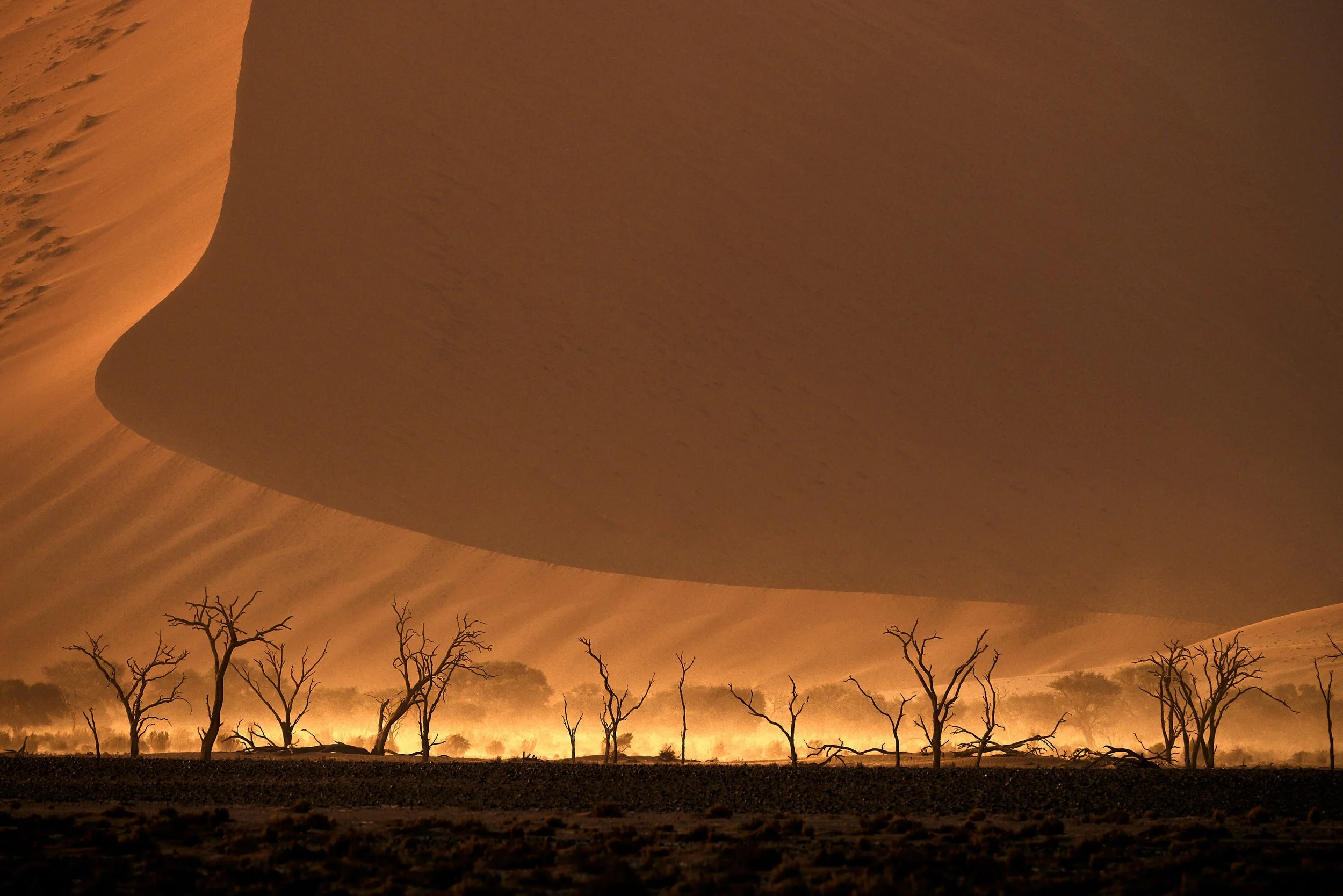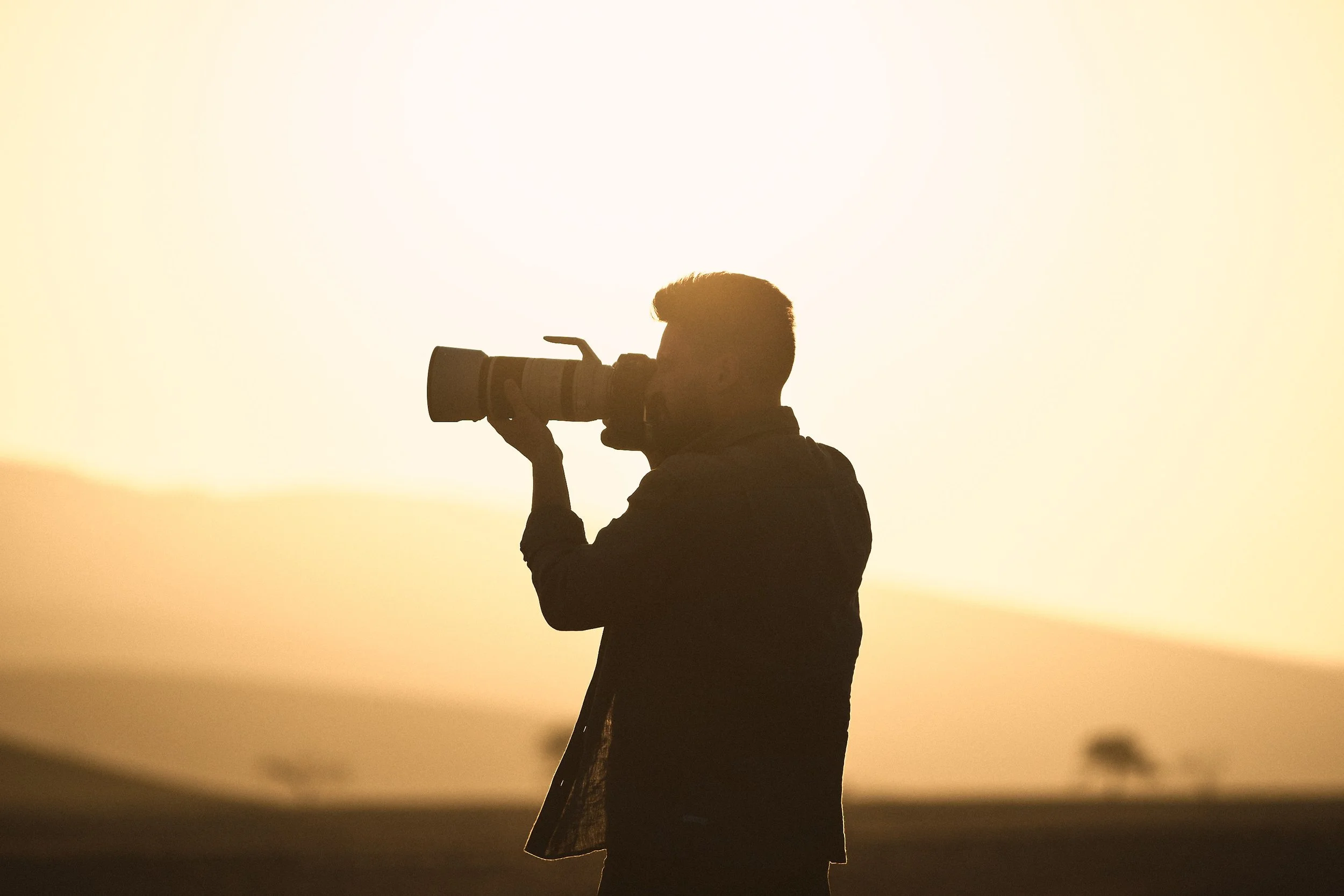What’s in My Camera Bag for a Self-Drive Safari
There’s something wildly liberating and mildly terrifying about a self-drive safari.
No guide. No backup. No radio chatter tipping you off about lion sightings. Just you, your 4x4, a map filled with hopeful dots, and that low, excited rumble in your chest every time you hear a branch snap in the bush.
I’ve taken many of these trips over the years, through Namibia, Botswana, and Zambia. And every time I pull out of that last town and watch the signal bars vanish, I feel the same nervous thrill: Did I pack correctly?
The answer is never “perfectly.” But I’ve refined my setup to a point where it finally works for me. So, for anyone planning a self-drive adventure, whether it’s your first or fiftieth, here’s what’s in my camera bag and why.
This isn’t theory. This is the dusty, tested, sand-in-the-crevices reality of photographing wildlife from a 4x4 in the middle of nowhere.
A herd of elephants
Let’s Start With the Core Gear (Bodies + Lenses)
On my most recent trip to Botswana and Zambia, I ran a two-body setup that I’d honestly struggle to improve.
Canon EOS R5
Canon EOS R3
Why two bodies? Because switching lenses with a lion 20 meters away is not an option. Also, you’re often in tight quarters inside the vehicle. Having each body ready with a different focal length saves time and frustration.
Main Lenses:
Canon RF 100–300mm f/2.8L IS USM (on the R5)
Canon RF 600mm f/4L IS USM (on the R3)
This setup gave me full range: the 100–300 on the R5 (with its high resolution) for scenes, wider wildlife shots, and flexibility; and the 600mm on the R3 for clean reach and unbeatable speed—especially for birds in flight or distant predators.
The combo is heavy, yes, but from the driver’s seat, it’s manageable. Additionally, both lenses can be used with extenders, which is a significant advantage. The 600mm becomes an 840mm f/5.6 with a 1.4x. I used this more than I thought, especially with distant elephants at Deception Valley or skittish antelope in the Kalahari.
Working with a single camera body ? Check out this comparison of 600mm vs 100-500mm: Which Wildlife Lens Should You Pack?
Second-Tier Lenses (aka “They Still Earn Their Spot”)
I don’t bring anything I don't plan to use regularly. But a few compact workhorses round out my kit:
Canon RF 24–105mm f/4L IS USM – This is my go-to for wider scenes, car camp shots, or those rare moments when wildlife gets really close. Handy in campsites like Magotho, where elephants sometimes pass through at 10 meters.
Canon RF 15–35mm f/2.8L IS USM – For landscape context, behind-the-scenes shooting, or Milky Way shots if we camp somewhere remote with no moon. Shot one of my favourite astro frames with this at Passarge Valley.
RF 1.4x & 2x Extenders – The 1.4x lives with the 600mm half the time. The 2x is rarely used, but I like having it. Sometimes, when animals are too far for even the 600mm+1.4x combo, it’s better to have it and not use it than the other way around.
Stabilisation & Mounts: Shooting From the Vehicle
Now, this part is huge. If you’re doing self-drive, you need a shooting setup that lets you be fast, flexible, and stable without a tripod.
Here’s what works for me:
Modified Eckla Eagle Car Mount
This is the MVP of my self-drive kit. I drilled the top plate to fit suction cups and bolted on a fluid head (Manfrotto 502AH or Sachtler Ace XL, depending on lens weight). I attach it outside the passenger window; rock solid.
It lets me shoot video and stills with buttery smooth movement. Perfect for longer clips, bird sequences, and any other situations where handheld footage would be too shaky. I made a whole YouTube video about it because people kept asking what the heck I was filming from the car.
F-Stop Tripod Platform with a Compact Tripod (Gitzo Mountaineer)
Used only outside the car or in camp. Honestly, I rarely shoot on a tripod during game drives, but when I do, it's essential for astrophotography or recording myself at camp.
Support Gear (Because Tech Can Be a Diva in the Bush)
This stuff isn’t flashy, but without it, everything else falls apart.
Power:
Power Inverter (600W) – Plugs into the vehicle’s 12V outlet, charges my laptop, drone batteries, and anything USB-C.
Bluetti EB3A Power Station – Total game changer. Small, solar-chargeable, runs my laptop and charges batteries when the car is off.
Multiple Camera Batteries (6 x R5, 6 x R3) – Rotate daily. I always keep at least four fully charged.
USB Power Bank (10,000–20,000mAh) – For phones, GoPro, Insta360.
Data:
SanDisk Extreme Pro CFexpress + SD Cards – I overpack here. Better safe than sorry.
Gnarbox 2.0 SSD (backup unit) – I do a backup every evening. You do not want to lose a week of leopard sightings because a card is corrupted.
1TB Samsung T7 SSDs (x3) – Lightweight, fast, and easy to organise folders by location or day.
Video & BTS Kit (Because Content Is King)
Even when I’m focused on stills, I film a ton. Here’s my lean field video kit:
GoPro Hero 9 – Mounted on a windshield suction cup or head strap and used for time lapses or POV of setting up camp.
Canon Powershot V1 – My dashcam and vlog cam in one. Used it heavily in Botswana. Performs well in bright light, even in dusty conditions.
Atomos Ninja V – Records HDMI out of the R5 or R3 for a clean viewfinder POV. Especially helpful when teaching or documenting settings.
RODE VideoMic Pro+ – Audio is half the video, don’t skimp here. Mounted either on my primary camera or on a small boom arm in the car.
The Actual Bag (And How I Pack It)
I use an F-Stop Tilopa backpack with an XL ICU (Internal Camera Unit). It’s rugged, weather-resistant, and fits under my legs in the car if needed.
But for in-car organisation, I do this:
Camera bodies with lenses stay out of the bag, ready to go.
I use a soft crate-style box for accessories, extenders, audio, and filters.
Lens pouches keep things safe and make it easy to grab just what I need.
Other Essentials I Never Leave Without
Microfiber cloths (x10) – You will need to wipe dust constantly.
Lens blower + small brush – Critical for dusty parks like CKGR.
Rain covers – Even in the dry season, freak storms can hit.
Gaffer tape – Fixes everything. Seriously.
Notebook + Pen – For sightings, settings, stories. Helps later when organising content.
Field guide – I still use books. Digital is great, but nothing beats a real guide on your lap when ID-ing a new bird.
Headlamp – You’ll thank me at camp when you drop something at night.
Sand dunes of the Sossusvlei
What I Leave Behind (Lessons the Hard Way)
Drone – Most national parks ban them. Plus, it attracts unwanted attention.
Laptop Charger Brick (220V) – Unless your car has a 220V inverter, it’s dead weight. Use USB-C or power stations.
Too Many Lenses – I used to bring a 70–200mm and a 35mm prime. Never touched them. More lenses = more stress. Stick to 2–3 max.
Big Tripod – Just no. It’s too bulky, rarely needed, and gets in the way. Compact or nothing.
Final Thoughts
Packing for a self-drive safari is an art. You need to think like a wildlife photographer, a field technician, and a minimalist all at once. And while gear is essential, knowing how to use it fast, safely, and creatively in real conditions is what really gets the shot.
My advice? Start with a solid two-lens combo, dial in your shooting workflow, and test everything before leaving. Don’t overpack, don’t under-prepare.
Your camera bag should feel like a tool chest—not a museum collection. And in the wild, the simpler your setup, the more creative freedom you’ll have.
Want to know how I travel with big camera gear?
Ready to experience an authentic self-drive safari?
👉 Join the waitlist for the Kalahari Safari Adventure – it’s wild, raw, and life-changing.






